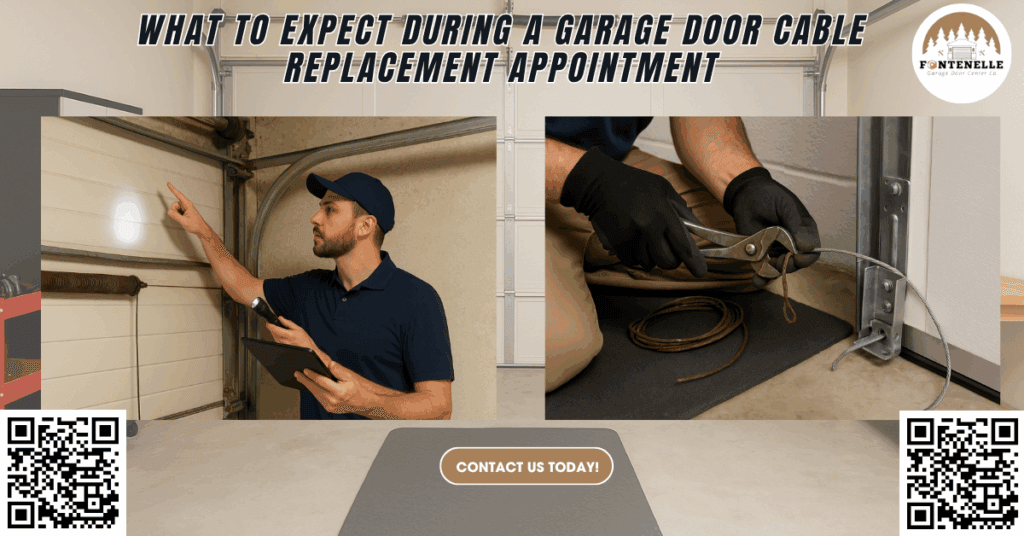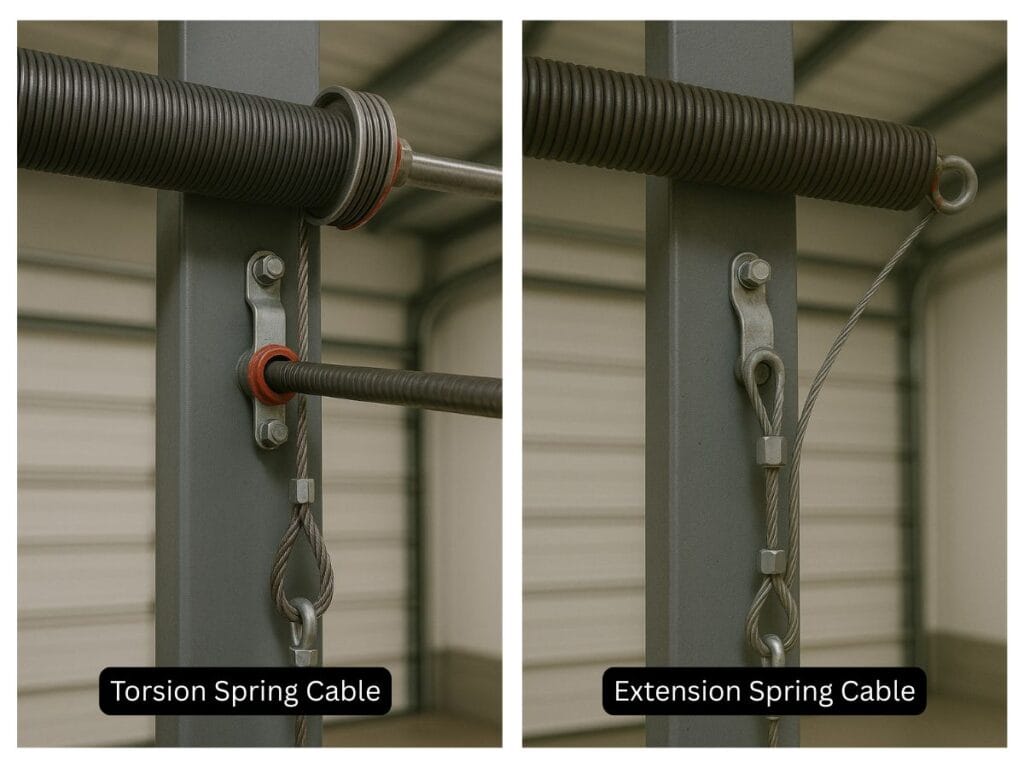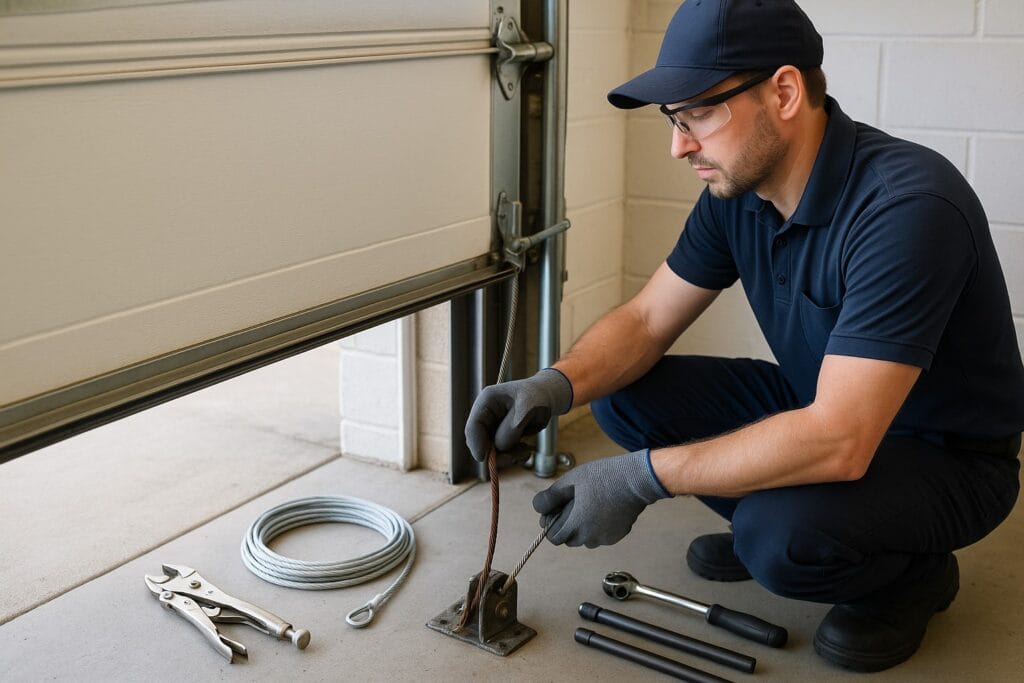What to Expect During a Garage Door Cable Replacement Appointment

It was just past 7:00 AM when a homeowner in Bellevue called in a panic: her garage door had slammed shut without warning and wouldn’t budge. Her car was trapped inside, and she had no idea what had gone wrong. Upon arrival, our technician discovered that the broken garage door cable was the culprit. The frayed old cable had finally snapped due to years of wear and rust. This situation isn’t unique. Garage door cable failures are one of the top causes of garage door repairs across the U.S.
According to the U.S. Consumer Product Safety Commission, over 20,000 garage door-related injuries occur annually. Many of these injuries stem from failed parts like door cables, springs, and other high-tension components. A broken cable may seem like a small issue, but it compromises the entire garage door system, potentially leading to property damage, personal injury, or complete system failure. That’s why garage door cable replacement isn’t just a convenience; it’s a critical repair task that should be performed with caution, the right tools, and professional help.
At Fontenelle Garage Door Center Co., we believe in empowering our customers with knowledge. Understanding what happens during a garage door cable replacement appointment helps reduce stress and ensures a safer experience. Whether you’re dealing with a broken garage door, planning for regular maintenance, or exploring signs of wear, this step-by-step guide will walk you through the entire process, provide actionable tips, and explain how our professional services ensure the safe operation of your garage door.
What Is a Garage Door Cable and Why Is It Important?
A garage door cable plays a crucial role in the overall operation of your garage door system. These steel braided cables work alongside the garage door springs, either torsion springs or extension springs, to lift and lower the heavy garage door evenly and safely. Positioned on each side of the door, the cables wind around a cable drum (in torsion systems) or pulley (in extension spring systems), counterbalancing the spring tension.

Without these cables, the garage door opener would be unable to control the door’s movement, and the spring system would be dangerously unbalanced. A broken cable or one that’s frayed and hanging loosely can cause the door to slam shut, go off track, or refuse to open at all. This not only damages other parts of the garage door system, such as rollers, hinges, or the bottom bracket, but also puts you at risk for serious injury. Therefore, maintaining the integrity of your garage door cables is essential for safe and smooth operation.
Signs You Might Need a Garage Door Cable Replacement
Recognizing the early signs of garage door cable problems can prevent more serious damage and costly repairs. One common indicator is that your garage door starts to lift unevenly or appears crooked when opening. This usually means one of the door cables has snapped or slipped off the cable drum. You may also hear grinding or squealing noises, suggesting that cables are fraying or dragging against other metal garage door parts.
Another red flag is visible rust, fraying, or corrosion on the cables themselves. Exposure to moisture, salt, and temperature changes can cause the steel wires to corrode over time, especially if maintenance is neglected. Also, if the garage door feels heavier than usual or requires more effort to lift manually, that could mean the cables are no longer properly supporting the spring tension. And if the garage door opener seems to struggle, it might be compensating for faulty or broken cables.
Don’t wait for a full failure. These issues are your garage door’s way of telling you it’s time for a cable replacement.
Step 1: Scheduling the Appointment
When you call Fontenelle Garage Door Center Co. at (402) 674-4281, our support team will guide you through a few important questions. We’ll ask about your specific garage door issues, whether the door is stuck open or closed, and whether you have a residential or commercial garage door. This information helps us prepare the right tools, parts, and safety equipment for the job.
We understand how disruptive a malfunctioning garage door can be. That’s why we offer same-day service, emergency appointments, and convenient scheduling to minimize downtime. When booking, our customer support staff will provide you with a time window, answer your initial questions, and walk you through what to expect during the visit.
Step 2: Arrival and Initial Inspection
On the day of the appointment, our trained technician will arrive on time, fully equipped with a service vehicle stocked with garage door parts, replacement cables, and personal protective equipment (PPE) such as safety glasses, gloves, and high-tension tools. The first thing we do is perform a comprehensive inspection of your garage door system to verify the root cause of the problem.
This inspection includes checking the door’s balance, inspecting the garage door cables, examining the cable drums, bottom brackets, and evaluating the condition of the springs, whether they’re torsion springs or extension springs. We also check the garage door opener, tracks, rollers, pulleys, and other components for any signs of wear or damage. If any additional repairs are necessary beyond the cable replacement, we’ll explain them clearly and offer transparent pricing before beginning work.
Step 3: Safety First – Securing the Garage Door
Before starting the cable replacement, our top priority is safety for both the technician and your property. We take essential safety precautions by disconnecting the garage door opener and securing the garage door in place using locking pliers, C-clamps, or brackets. This prevents any unintended movement during the repair, especially since we’re dealing with parts under high tension.
We also assess the spring tension. If you have a torsion spring system, the spring’s force must be relieved using a winding bar before touching the cable drum. For extension spring systems, the tension is addressed by securing the pulley and springs. Improper handling of these parts can lead to serious injuries, which is why this step should only be handled by professional garage door technicians.
Step 4: Removing the Broken or Worn Cables
Once the garage door system is secure, we move on to removing the old cable. If the cable has snapped, we carefully detach any remaining fragments from the bottom bracket and drum. If it’s simply worn or frayed, the technician unspools it from the cable drum or pulley system. We then inspect the drum, bolts, and brackets for signs of wear, corrosion, or cracks that could impact the operation of the new cables.
In some cases, we find that old cables have slipped off the drum due to uneven spring tension or misalignment in the door tracks. In others, debris buildup or lack of lubrication may have caused premature cable wear. We clean the mounting points thoroughly and prepare the area for a secure new cable installation.
Step 5: Installing New Cables
Installing new garage door cables is a precise job that requires technical know-how. Each new cable is matched to the garage door’s specifications, including length, thickness, and compatibility with torsion or extension springs. The technician attaches one end of the cable to the bottom bracket and then threads the cable properly into the cable drum or pulley system.
Next, we restore or adjust the spring tension to ensure smooth lifting. For torsion systems, the spring is wound using specialized tools, and we carefully track the number of turns to avoid overtightening. For extension systems, the pulley cables are looped and tensioned to mirror the opposite side. Alignment is critical, imbalanced cables can cause jerky movement, door strain, or complete failure.

Step 6: Testing and Adjustments
After the new cables are installed, the technician reconnects the garage door opener and begins the testing process. This involves opening and closing the garage door multiple times while observing its movement. We look for smooth transitions, consistent balance, and even cable winding on the drums. If the door jerks, sticks, or makes noise, we make fine adjustments to the cable tension, track alignment, or spring balance.
Testing also includes verifying that the garage door opener and safety sensors function properly. For universal doors, we test compatibility and smooth operation with all connected control systems, including wall buttons, remotes, and mobile apps. Every adjustment ensures that your garage door system is restored to peak performance.
Step 7: Final Safety Checks
The appointment wraps up with a full set of final inspections and safety checks. We lubricate all moving parts, rollers, hinges, pulleys, and cable drums using garage door-safe lubricants that prevent corrosion and extend the life of key components. We also inspect the auto-reverse feature of your garage door opener, which is essential for preventing injury or damage in case of an obstruction.
We perform a final balance test to confirm that the garage door remains in place when stopped halfway. This ensures proper spring tension and indicates that both garage door cables are supporting the door evenly. We remove all tools, packaging, and old cables, leaving your garage clean and safe for use.
How Long Does a Garage Door Cable Replacement Take?
A typical garage door cable replacement takes about 60 to 90 minutes, depending on the complexity of your garage door system. Factors that may affect the time include whether one or both cables are being replaced, whether your system uses torsion springs or extension springs, and whether additional garage door parts (like drums, rollers, or brackets) also need repairs or replacement.
For commercial garage doors or custom systems, the process may take slightly longer. If your garage door has suffered secondary damage like a bent track, damaged opener, or broken hinges we may recommend additional repairs that can be handled in the same appointment.
What Should You Do Before the Appointment?
You can help ensure a smooth appointment by preparing your garage space ahead of time. If your garage door is stuck in the closed position, try to remove any vehicles parked inside before the technician arrives. Clear the area near the garage door tracks, opener, and floor to allow safe access to all key components.
Please keep children and pets away from the work area, as we’ll be working with tools and high-tension springs. If you’re available during the appointment, we’ll gladly walk you through the replacement process, answer your questions, and demonstrate the safe operation of your garage door after the work is completed.
Frequently Asked Questions (FAQs)
Q: Can I replace the garage door cables myself?
A: We strongly advise against DIY cable replacements. The job involves high-tension springs and specialized tools that can be dangerous without the right experience. Leave it to professional garage door technicians to ensure safety and effectiveness.
Q: Do I need to replace both cables if only one is broken?
A: Yes. Even if only one cable breaks, the other is likely close to failing as well. Replacing both ensures balanced movement and prevents uneven stress on your garage door system.
Q: What causes cables to wear out?
A: Age, weather exposure, corrosion, dirt buildup, and lack of maintenance are common culprits. Rusted or frayed garage door cables are more likely to snap unexpectedly.
Q: How often should garage door cables be checked?
A: At least once a year, as part of your routine garage door maintenance. Regular inspections help spot issues early and prevent costly repairs later on.
How Can Fontenelle Garage Door Center Co. Help You?
At Fontenelle Garage Door Center Co., we are your trusted experts for garage door cable replacement in Bellevue, NE, and surrounding areas. Whether your garage door is stuck, slanted, squeaking, or completely non-functional, we’ll provide fast, reliable, and professional help, backed by years of experience and customer trust. Our services are designed for both residential and commercial garage doors, and we handle everything from custom installations to emergency repairs.
We use top-grade parts, apply proven methods, and never cut corners when it comes to your family’s safety. Our technicians are fully trained, courteous, and equipped with the right tools to restore your garage door to safe, smooth operation.
📍 Address: 1001 Fort Crook Rd N, Bellevue, NE 68005
📞 Phone: (402) 674-4281
Don’t wait for a broken cable to become a safety hazard. Call us today or book online HERE, for professional cable replacement, maintenance, or a full system tune-up.
Final Thoughts
Garage door cables may be small in size, but they’re giants in terms of their importance to the safe and reliable operation of your garage door system. Ignoring the signs of wear, delaying repairs, or attempting a DIY fix can lead to costly damage and serious injury. That’s why understanding the replacement process, recognizing warning signs, and partnering with professional garage door services like Fontenelle Garage Door Center Co. is the smartest path forward.
Make garage door maintenance a priority, and don’t wait for your system to fail before taking action. With proper care, timely repairs, and expert service, your garage door will serve you safely for years to come. Ready to schedule your appointment? We’re just a call away.
